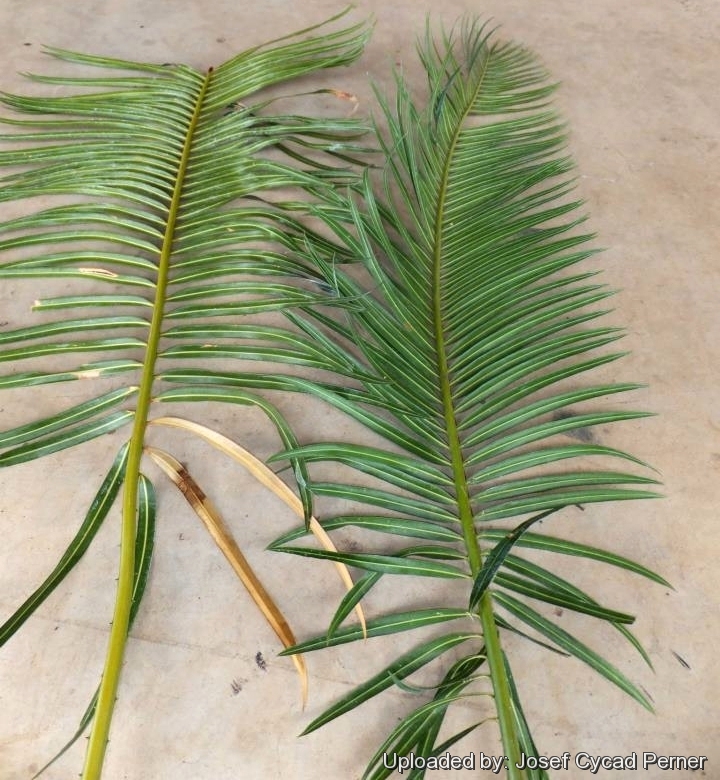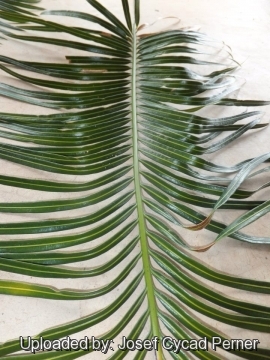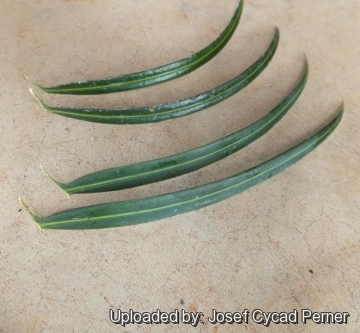Accepted Scientific Name: Cycas seemannii A.Br.
Sitzungsber. Acad. Wien, Math.-Nat. li. Abth. 1876: 114 (1876)

Cycas neocaledonica Photo by: Josef Cycad Perner
Cycas seemannii (unknown provenance) on left and Cycas neocaledonica (morphotype from New Caledonia) on right, both are growing in the same media beside to each other in 30% shade structure.
Origin and Habitat: New Caledonia (western Pacific south of about 12° S)
Habitat and ecology: This cycad favours a coastal habitat. It is considered vulnerable as its habitat has been continually disturbed by agricultural ventures.
Synonyms:
See all synonyms of Cycas seemannii
back
Accepted name in llifle Database:Cycas seemannii A.Br.Sitzungsber. Acad. Wien, Math.-Nat. li. Abth. 1876: 114 (1876)Synonymy: 5
back
Description: Cycas neocaledonicaSN|28872]]SN|31847]] Linden (1881) is a nomen nudun (an avowed new name unaccompanied by a description or diagnosis) published by Linden in the Illustration Horticole (1881), also cited as Greguss or Linden ex Greguss (in reference to Greguss 1968: 42, 176). Linden only listed the name, and Greguss merely asserted that, on anatomical grounds, this was a species distinct from all others that he had studied. He did not furnish a valid description. The plants in question on New Caledonia are Cycas seemanniiSN|28872]]SN|28872]].
Remarks: Cycas seemanniiSN|31847]]SN|28872]] (Seemann's sago) is a widespread and variable species occuring on several of the Fijian Islands, on Vanuatu, the Tonga Island group and New Caledonia. The geographical or morphological form from New Caledonia (or Cycas neocaledonicaSN|28872]]SN|31847]]) essentially has nothing sharp or pointed to poke you. The leaf stems are without prickles or spines. Leaves are green and shiny, however the colouring, size and density of leaves is greatly influenced by the conditions of culture, at lower light levels the leaves are less numerous, delicate and thin, while with strong solar radiation the leaves are stronger with a darker tint, but others forms of Cycas seemanniiSN|28872]]SN|28872]] are similar and plants from other localities look more like it (if not the same) and it is hard to tell apart one from the others, if not for the geographical provenance and they are not considered distinct.
For more details see: Cycas seemanniiSN|31847]]SN|28872]].
Subspecies, varieties, forms and cultivars of plants belonging to the Cycas seemannii group
 Cycas neocaledonica Linden: ( = Cycas seemannii) This is the geographical or morphological form from New Caledonia Islands. Distribution: New Caledonia (western Pacific south of about 12° S).
Cycas neocaledonica Linden: ( = Cycas seemannii) This is the geographical or morphological form from New Caledonia Islands. Distribution: New Caledonia (western Pacific south of about 12° S). Cycas seemannii A.Br.: has narrow leaflets with short, usually spine-free petiole. Megasporophyll triangular with a long terminal spine and up to 18-30 short lateral spines. Distribution: Fijian Islands, on Vanuatu, the Tonga Island group and New Caledonia.
Cycas seemannii A.Br.: has narrow leaflets with short, usually spine-free petiole. Megasporophyll triangular with a long terminal spine and up to 18-30 short lateral spines. Distribution: Fijian Islands, on Vanuatu, the Tonga Island group and New Caledonia.
Bibliography: Major references and further lectures
1) Hill, K.D. 2010. Cycas seemannii. The IUCN Red List of Threatened Species. Version 2014.3. <www.iucnredlist.org>. Downloaded on 17 November 2014.
2) Terrence Walters, Roy Osborne “Cycad Classification: Concepts and Recommendations” CABI, 12/gen/2004
3) Cheryll Williams “Medicinal Plants in Australia Volume 3: Plants, Potions and Poisons” Rosenberg Publishing, 01/Jul./2012
4) Jules Janick, Robert E. Paull “The Encyclopedia of Fruit and Nuts” CABI, 2008
5) The Cycad Pages “Cycas seemannii” Royal Botanic Gardens Sydney Written and maintained by Ken Hill 1998-2010 Maintained by Leonie Stanberg and Dennis Stevenson 2010-2012 >http://plantnet.rbgsyd.nsw.gov.au> Web. 13 Nov. 2014.
6) Haynes J.L, “World List of Cycads: A Historical Review” IUCN/SSC Cycad Specialist Group, 2012
7) Boris Lariushin “Cycadaceae Family” Lulu.com
8) Hill, K.D. & Osborne, R.O. “Cycads of Australia.” Kangaroo Press, Sydney. 2001
9) Jones, D.L. “Cycads of the World.” 2nd edn. Reed, Sydney. 2002.
10) Norstog, K.J. and Nichols, T.J. “The Biology of the Cycads.” Cornell University Press, Ithaca.1997
11) Walters, T. and Osborne, R. “Cycad Classification Concepts and Recommendations.” CABI Publishing, Wallingford UK. 2004.
12) Whitelock, L.M. “The Cycads.” Timber Press, Portland, Oregon. 2002
13) "Cycas seemannii". In: Cycads. Palm and Cycad Societies of Australia (PACSOA). 24 November 2013 Web. 13 Nov. 2014
14) Phil Bergman, Jungle Music Palms and Cycads "Cycas neocaledonica" <http://www.junglemusic.net> Web. 13 Sept. 2015
 Cycas seemannii Photo by: Josef Cycad Perner
Cycas seemannii Photo by: Josef Cycad Perner Cycas neocaledonica. Photo by: Josef Cycad Perner
Cycas neocaledonica. Photo by: Josef Cycad Perner Cycas seemannii above and Cycas neo-calidonica below. both are growing in the same media beside to each other in 30% shade struc Photo by: Josef Cycad Perner
Cycas seemannii above and Cycas neo-calidonica below. both are growing in the same media beside to each other in 30% shade struc Photo by: Josef Cycad PernerSend a photo of this plant.The gallery now contains thousands of pictures, however it is possible to do even more. We are, of course, seeking photos of species not yet shown in the gallery but not only that, we are also looking for better pictures than those already present.
Read More... Cultivation and Propagation: Cycas neocaledonica (Cycas seemanniiSN|31847]]SN|28872]]) is suited to tropical regions which have a seasonally dry climate both on the seaside or inland. It is easy to grow, tolerating dry periods. Cycas neocaledonicaSN|28872]]SN|31847]] is a striking tropical accent plant ideal for sunny borders and large containers. It is often the focal point in a large yard. It is becoming more and more common and turning out to be a great landscape plant.
Growth rate: It is a robust, fast-growing species, one of the fastest and easiest Cycas species. Because of its growth habit, fertilize only when terminal bud begins to swell, indicating the start of the annual growth cycle.
Exposure: Plant this cycad in full to partial sun.
Soil: Needs a well drained spot, with deep soi. Although this species naturally grows on coral-based or limestone soils with organic matter, avoid planting it in highly alkaline soils to avoid nutritional deficiencies and yellowed foliage.
Maintenance: Minimal; removal of offsets if desired, removal of spent fronds.
Hardiness: This is a tender evergreen species that is tropical in its needs.
Aerosol salt tolerance: It is very tolerant of extreme coastal and beach exposure, as well as salt spray. This is one of the most salt tolerant cycads!
Use: Landscape as cultivated perennial in warm, coastal areas; House-plant or interior-scape, as container plant in cool areas, as well very well suited to bonsai culture. Seeds are ground and made into a type of bread and the fresh male cones are said to be edible.
Pests and diseases: Watch out for scale infestations, especially Asian aulacapsis scale, which will kill a mature plant if untreated.
Maintenance: This is an evergreen species that should only have dead foliage pruned off, never the healthy green leaves.
Propagation: Seed. As a slow growing plant, the seed can take from 6–18 months to germinate. After fertile seeds are collected, they usually need several months of storage before the inner embryo is ready to germinate. Therefore, it is best to clean the seeds of external fruit and set them aside before attempting to propagate the seeds. Usually seeds are ready to germinate after 2-4 month, the germination is rapid and almost all seeds germinate up within 2 month.












